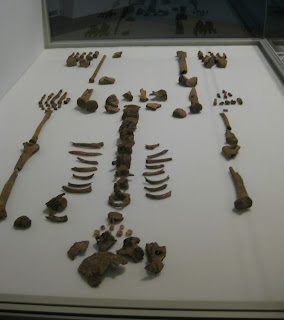A rather pedestrian day of digging actually. The hoped for road did not emerge even with several successive sweeps of troweling. It must be down there someplace but still under a layer of thick, black dirt. The worms like it. At the end of the day it looked like this.
Tomorrow we are being shifted to a new patch. I always have mixed feelings leaving even an unrewarding trench. You just imagine a future team finding fascinating stuff another centimeter down.
Looking at a site "in the rough" as above it is difficult to imagine what it will look like in the future. After all the archeology has been analyzed the site gets "conserved". Which means that the masons reinforce and patch so as to create something like the original features. It helps visitors understand the site.
But sometimes things are lost.
Oh my, but the Romans were big on monuments. Statues, triumphal arches and so forth. The practice is not extinct today. Here is a memorial next to the cafe on site. It recognizes and honors the Roman soldiers who lived and worked there. But some people do not get memorials.
Four years ago I was digging near a barracks block. The next year, inside the building I was helping excavate, they found a skeleton under the barracks floor. The coroner was called, this being Britain and all, and a verdict was returned basically saying "murder by person or persons unknown, circa 230 AD".
As it turned out this was the skeleton of a ten year old person, probably female, whose remains were placed under the floor of the barracks with hands bound. It is assumed that she was murdered. It was possible with isotope analysis to establish that she lived her early life in the Mediterranean region. Did she come to the northern frontier of Britannia as a slave? It it hard to imagine that the child of an officer would come to such a tragic end.
The crime happened here.
Her bones are now in the site museum.
There is no marker on the site, no recognition of the tragedy some 18 centuries ago.
That seemed wrong, so I picked a few flowers - growing so abundantly in the brilliant Northumberland springtime.


3 comments:
As to the murder victim, it is possible that the climate was warmer in the 4th Century, coming off of the Roman Climate Optimum. What seems Mediterranean to us may have been southern England.
And can I just say that I'd love to do a dig with you sometime, although it's rather far fetched? I'll even spring for the bitter in the local.
The origin of the unfortunate victim was based on isotope analysis. They vary with water supply as I understand it. CSI meets Agatha Christie...
The far fetched sometimes becomes possible. But you would have to detach your nose from its usual position on the grindstone!
I shall lift a pint with you in mind...
Tacitus
Seems right to leave her flowers.
Post a Comment